Securing a Child Restraint Designed for the LATCH System
WARNING!
If a LATCH-type child restraint is
not attached to anchors, the child
restraint will not be able to protect
the child correctly. In a crash, the
child could be seriously injured or
killed. Install a LATCH-type child
restraint properly using the
anchors, or use the vehicle safety
belts to secure the restraint,
following the instructions that
came with the child restraint and
the instructions in this manual.
WARNING!
Do not attach more than one child
restraint to a single anchor.
Attaching more than one child
restraint to a single anchor could
cause the anchor or attachment
to come loose or even break
during a crash. A child or others
could be injured. To reduce the
risk of serious or fatal injuries
during a crash, attach only one
child restraint per anchor.
WARNING!
Children can be seriously injured
or strangled if a shoulder belt is
wrapped around their neck and
the safety belt continues to
tighten. Buckle any unused safety
belts behind the child restraint so
children cannot reach them. Pull
the shoulder belt all the way out
of the retractor to set the lock,
if the vehicle has one, after the
child restraint has been installed.
Notice:
Do not let the LATCH
attachments rub against the
vehicle’s safety belts. This may
damage these parts. If necessary,
move buckled safety belts to
avoid rubbing the LATCH
attachments.
Do not fold the empty rear seat
with a safety belt buckled. This
could damage the safety belt or
the seat. Unbuckle and return the
safety belt to its stowed position,
before folding the seat.
If you need to secure more than one child restraint in the rear seat, see Where to Put the Restraint.
You cannot secure three child restraints using the LATCH anchors in the rear seat at the same time, but you can install two of them.
If you want to do this, install one LATCH child restraint in the passenger-side position, and install the other one either in the driver-side position or in the center position. If you need to install child restraints in both the center and driver-side position, the one in the center seating position will need to be secured using the vehicle safety belts instead of the LATCH anchors.
Refer to the following illustration to learn which anchors to use.
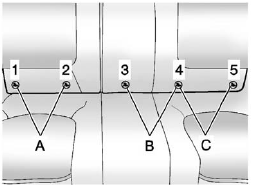
A. Passenger Side Rear Seating
Position and Lower Anchors
1 and 2
B. Center Rear Seating Position
and Lower Anchors 3 and 4
C. Driver Side Rear Seating
Position and Lower Anchors
4 and 5
There are five lower LATCH anchors in the rear seat.
• Use anchors 1 and 2 when installing a child restraint using LATCH in seating position A.
• Use anchors 3 and 4 when installing a child restraint using LATCH in seating position B.
• Use anchors 4 and 5 when installing a child restraint using LATCH in seating position C.
Installing child restraints using LATCH in seating positions B and C at the same time is prohibited.
Make sure to attach the child restraint at the proper anchor location.
This system is designed to make installation of child restraints easier.
When using lower anchors, do not use the vehicle's safety belts.
Instead use the vehicle's anchors and child restraint attachments to secure the restraints. Some restraints also use another vehicle anchor to secure a top tether.
1. Attach and tighten the lower attachments to the lower anchors. If the child restraint does not have lower attachments or the desired seating position does not have lower anchors, secure the child restraint with the top tether and the safety belts. Refer to the child restraint manufacturer instructions and the instructions in this manual.
1.1. Find the lower anchors for the desired seating position.
1.2. Put the child restraint on the seat.
If the head restraint interferes with the proper installation of the child restraint, the head restraint may be removed. See “Head Restraint Removal and Reinstallation” at the end of this section.
1.3. Attach and tighten the lower attachments on the child restraint to the lower anchors.
2. If the child restraint manufacturer recommends that the top tether be attached, attach and tighten the top tether to the top tether anchor, if equipped. Refer to the child restraint instructions and the following steps:
2.1. Find the top tether anchor.
Open the cover to expose the anchor.
2.2. Route, attach, and tighten the top tether according to the child restraint instructions and the following instructions:
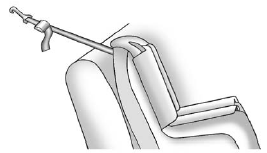
• If the position you are using does not have a headrest or head restraint, or the headrest or head restraint has been removed, and you are using a single tether, route the tether over the seatback.
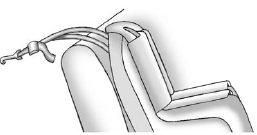
• If the position you are using does not have a headrest or head restraint, or the headrest or head restraint has been removed, and you are using a dual tether, route the tether over the seatback.
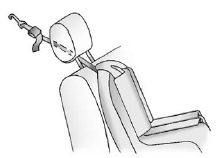
• If the position you are using has an adjustable headrest or head restraint and you are using a single tether, route the tether under the headrest or head restraint and in between the headrest or head restraint posts. See Head Restraints.
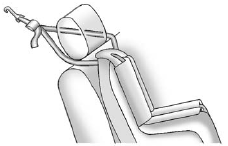
• If the position you are using has an adjustable headrest or head restraint and you are using a dual tether, route the tether around the headrest or head restraint.
3. Before placing a child in the child restraint, make sure it is securely held in place. To check, grasp the child restraint at the LATCH path and attempt to move it side to side and back and forth. There should be no more than 2.5 cm (1 in) of movement, for proper installation.
See also:
Hood Release
To open the hood:
1. Pull the hood release
handle inside the
vehicle. It is located
next to the parking
brake pedal near the
floor.
2. Then go to the front of the vehicle and pull the ...
Engine Oil Messages
CHANGE ENGINE OIL SOON
This message displays when the engine oil needs to be changed. When you change
the engine oil, be sure to reset the Oil Life System. See Engine Oil Life System
and Dr ...
When the System Does Not Seem To Work
Properly
Occasional missed alerts can occur under normal
circumstances and will increase in wet conditions.
The system does not need to be serviced due to an
occasional missed alert. The number of missed ...


